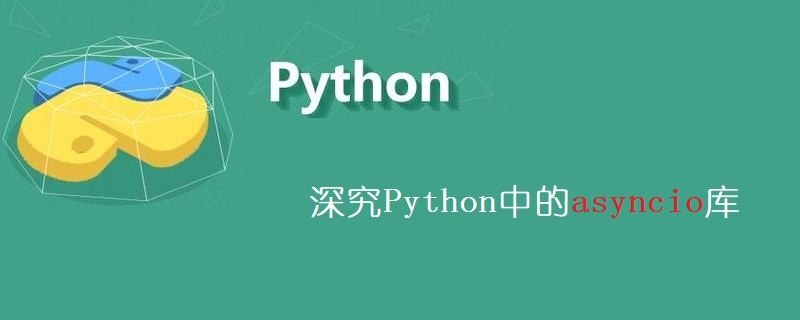深究Python中的asyncio库-asyncio的四个概念
核心概念
asyncio里面主要有4个需要关注的基本概念

Eventloop
Eventloop可以说是asyncio应用的核心,是中央总控。Eventloop实例提供了注册、取消和执行任务和回调的方法。
把一些异步函数(就是任务,Task,一会就会说到)注册到这个事件循环上,事件循环会循环执行这些函数(但同时只能执行一个),当执行到某个函数时,如果它正在等待I/O返回,事件循环会暂停它的执行去执行其他的函数;当某个函数完成I/O后会恢复,下次循环到它的时候继续执行。因此,这些异步函数可以协同(Cooperative)运行:这就是事件循环的目标。
Coroutine
协程(Coroutine)本质上是一个函数,特点是在代码块中可以将执行权交给其他协程:
❯ cat coro1.py
import asyncio
async def a():
print('Suspending a')
await asyncio.sleep(0)
print('Resuming a')
async def b():
print('In b')
async def main():
await asyncio.gather(a(), b())
if __name__ == '__main__':
asyncio.run(main())
这里面有4个重要关键点:
协程要用async def声明,Python 3.5时的装饰器写法已经过时,我就不列出来了。
asyncio.gather用来并发运行任务,在这里表示协同的执行a和b2个协程
在协程a中,有一句await asyncio.sleep(0),await表示调用协程,sleep 0并不会真的sleep(因为时间为0),但是却可以把控制权交出去了。
asyncio.run是Python 3.7新加的接口,要不然你得这么写:
loop = asyncio.get_event_loop() loop.run_until_complete(main()) loop.close()
好了,我们先运行一下看看:
❯ python coro1.py Suspending a In b Resuming a
看到了吧,在并发执行中,协程a被挂起又恢复过。
Future
接着说Future,它代表了一个「未来」对象,异步操作结束后会把最终结果设置到这个Future对象上。Future是对协程的封装,不过日常开发基本是不需要直接用这个底层Future类的。我在这里只是演示一下:
In : def c():
...: print('Inner C')
...: return 12
...:
In : future = loop.run_in_executor(None, c) # 这里没用await,None 表示默认的 executor
Inner C
In : future # 虽然c已经执行了,但是状态还是 pending。
Out: <Future pending cb=[_chain_future.<locals>._call_check_cancel() at /usr/local/lib/python3.7/asyncio/futures.py:348]>
In : future.done() # 还没有完成
Out: False
In : for a in dir(future):
...: if not a.startswith('_'):
...: print(a)
...:
add_done_callback
cancel
cancelled
done
exception
get_loop
remove_done_callback
result
set_exception
set_result
可以对这个Future实例添加完成后的回调(add_done_callback)、取消任务(cancel)、设置最终结果(set_result)、设置异常(如果有的话,set_exception)等。现在我们让Future完成:
In : await future Out: 12 In : future Out: <Future finished result=12> In : future.done() Out: True In : future.result() Out: 12
看到了吧,await之后状态成了finished。这里顺便说一下,一个对象怎么样就可以被await(或者说怎么样就成了一个awaitable对象)呢?给类实现一个__await__方法,Python版本的Future的实现大概如下:
def __await_(self):
if not self.done():
self._asyncio_future_blocking = True
yield self
if not self.done():
raise RuntimeError("await wasn't used with future")
return self.result()
这样就可以await future了,那为什么await future后Future的状态就能改变呢,这是因为用loop.run_in_executor创建的Future注册了一个回调(通过asyncio.futures.wrap_future,加了一个_call_set_state回调, 有兴趣的可以通过延伸阅读链接2找上下文)。
__await__里面的yield self不要奇怪,主要是为了兼容__iter__,给旧的yield from用:
In : future = loop.run_in_executor(None, c) Inner C In : future Out: <Future pending cb=[_chain_future.<locals>._call_check_cancel() at /usr/local/lib/python3.7/asyncio/futures.py:348]> In : def spam(): ...: yield from future ...: In : s = spam() In : next(s) Out: <Future pending cb=[_chain_future.<locals>._call_check_cancel() at /usr/local/lib/python3.7/asyncio/futures.py:348]> 新的替代yield from的用法await必须在异步函数(用 async def申明)中使用: In : def spam(): ...: await future ...: File "cell_name", line 5 SyntaxError: 'await' outside async function
Task
Eventloop除了支持协程,还支持注册Future和Task2种类型的对象,那为什么要存在Future和Task这2种类型呢?
先回忆前面的例子,Future是协程的封装,Future对象提供了很多任务方法(如完成后的回调、取消、设置任务结果等等),但是开发者并不需要直接操作Future这种底层对象,而是用Future的子类Task协同的调度协程以实现并发。
Task非常容易创建和使用:
# 或者用task = loop.create_task(a()) In : task = asyncio.ensure_future(a()) In : task Out: <Task pending coro=<a() running at /Users/dongwm/mp/2019-05-22/coro1.py:4>> In : task.done() Out: False In : await task Suspending a Resuming a In : task Out: <Task finished coro=<a() done, defined at /Users/dongwm/mp/2019-05-22/coro1.py:4> result=None> In : task.done() Out: True
asyncio并发的正确/错误姿势
在代码中使用async/await是不是就能发挥asyncio的并发优势么,其实是不对的,我们先看个例子:
async def a():
print('Suspending a')
await asyncio.sleep(3)
print('Resuming a')
async def b():
print('Suspending b')
await asyncio.sleep(1)
print('Resuming b')
async def s1():
await a()
await b()
有2个协程a和b,分别sleep1秒和3秒,如果协程可以并发执行,那么执行时间应该是sleep最大的那个值(3秒),现在它们都在s1协程里面被调用。大家先猜一下s1会运行几秒?
我们写个小程序验证一下:
def show_perf(func):
print('*' * 20)
start = time.perf_counter()
asyncio.run(func())
print(f'{func.__name__} Cost: {time.perf_counter() - start}')
大家注意我这个时间计数用的方法,没有用time.time,而是用了Python 3.3新增的time.perf_counter它是现在推荐的用法。我们在IPython里面验证下:
In : from coro2 import * In : show_perf(s1) ******************** Suspending a Resuming a Suspending b Resuming b s1 Cost: 4.009796932999961
看到了吧,4秒!!!,相当于串行的执行了(sleep 3 + 1)。这是错误的用法,应该怎么用呢,前面的asyncio.gather就可以:
async def c1(): await asyncio.gather(a(), b()) In : show_perf(c1) ******************** Suspending a Suspending b Resuming b Resuming a c1 Cost: 3.002452698999832
看到了吧,3秒!另外一个是asyncio.wait:
async def c2(): await asyncio.wait([a(), b()]) In : show_perf(c2) ... c2 Cost: 3.0066957049998564
同样是3秒。先别着急,gather和wait下篇文章还会继续对比。还有一个方案就是用asyncio.create_task:
async def c3(): task1 = asyncio.create_task(a()) task2 = asyncio.create_task(b()) await task1 await task2 async def c4(): task = asyncio.create_task(b()) await a() await task In : show_perf(c3) ... c3 Cost: 3.002332438999929 In : show_perf(c4) ... c4 Cost: 3.002270970000154
都是3秒。asyncio.create_task相当于把协程封装成Task。不过大家要注意一个错误的用法:
async def s2(): await asyncio.create_task(a()) await asyncio.create_task(b()) In : show_perf(s2) ... s2 Cost: 4.004671427999938
直接await task不会对并发有帮助*。asyncio.create_task是Python 3.7新增的高阶API,是推荐的用法,其实你还可以用
asyncio.ensure_future和loop.create_task: async def c5(): task = asyncio.ensure_future(b()) await a() await task async def c6(): loop = asyncio.get_event_loop() task = loop.create_task(b()) await a() await task In : show_perf(c5) ... c5 Cost: 3.0033873750003295 In : show_perf(c6) ... c6 Cost: 3.006120122000084
到这里,我们一共看到2种错误的,6种正确的写法。你学到了么?
下一节:深究Python中的asyncio库-线程并发函数
来源:PY学习网:原文地址:https://www.py.cn/article.html

